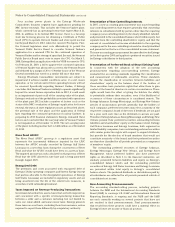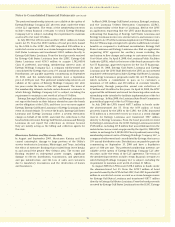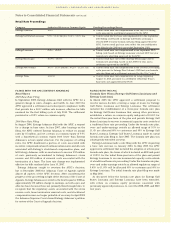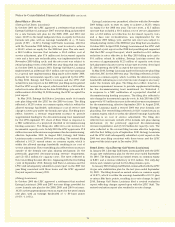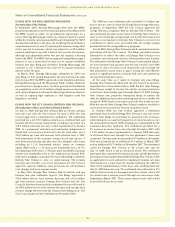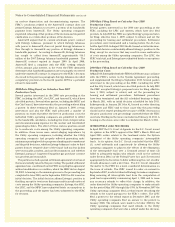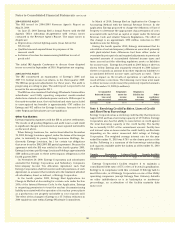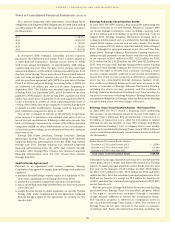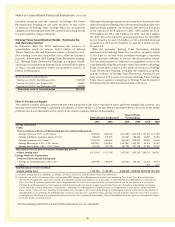Entergy 2010 Annual Report Download - page 78
Download and view the complete annual report
Please find page 78 of the 2010 Entergy annual report below. You can navigate through the pages in the report by either clicking on the pages listed below, or by using the keyword search tool below to find specific information within the annual report.
Notes to Consolidated Financial Statements continued
FILINGS WITH THE PUCT AND TEXAS CITIES (ENTERGY TEXAS)
Retail Rates
In December 2009, Entergy Texas filed a rate case requesting a
$198.7 million increase reflecting an 11.5% return on common
equity based on an adjusted June 2009 test year. The rate case
also includes a $2.8 million revenue requirement to provide
supplemental funding for the decommissioning trust maintained
for the 70% share of River Bend for which Entergy Texas retail
customers are partially responsible, in response to an NRC
notification of a projected shortfall of decommissioning funding
assurance. Beginning in May 2010, Entergy Texas implemented a
$17.5 million interim rate increase, subject to refund. Intervenors
and PUCT Staff filed testimony recommending adjustments that
would result in a maximum rate increase of, based on the PUCT
Staff’s testimony, of $58 million.
The parties filed a settlement in August 2010 intended to
resolve the rate case proceeding. The settlement provides for
a $59 million base rate increase for electricity usage beginning
August 15, 2010, with an additional increase of $9 million for
bills rendered beginning May 2, 2011. The settlement stipulates
an authorized return on equity of 10.125%. Baseline values were
established to be used in Entergy Texas’s request for a transmission
recovery factor that will be made in a separate proceeding. The
settlement states that Entergy Texas’s fuel costs for the period
April 2007 through June 2009 are reconciled, with $3.25 million of
disallowed costs, which were included in an interim fuel refund.
The settlement also sets River Bend decommissioning costs at
$2.0 million annually. Consistent with the settlement, in the third
quarter 2010, Entergy Texas amortized $11 million of rate case
costs. The PUCT approved the settlement in December 2010.
System Agreement Cost Equalization Proceedings
The Utility operating companies historically have engaged in the
coordinated planning, construction, and operation of generating
and bulk transmission facilities under the terms of the System
Agreement, which is a rate schedule that has been approved
by the FERC. Certain of the Utility operating companies’ retail
regulators and other parties are pursuing litigation involving
the System Agreement at the FERC. The proceedings include
challenges to the allocation of costs as defined by the System
Agreement and allegations of imprudence by the Utility operating
companies in their execution of their obligations under the
System Agreement.
In June 2005, the FERC issued a decision in the System Agreement
litigation that had been commenced by the LPSC, and essentially
affirmed its decision in a December 2005 order on rehearing. The
FERC decision concluded, among other things, that:
n The System Agreement no longer roughly equalizes total
production costs among the Utility operating companies.
n In order to reach rough production cost equalization, the
FERC imposed a bandwidth remedy by which each company’s
total annual production costs will have to be within +/- 11% of
Entergy System average total annual production costs.
n In calculating the production costs for this purpose under the
FERC’s order, output from the Vidalia hydroelectric power
plant will not reflect the actual Vidalia price for the year but is
priced at that year’s average price paid by Entergy Louisiana
for the exchange of electric energy under Service Schedule
MSS-3 of the System Agreement, thereby reducing the amount
of Vidalia costs reflected in the comparison of the Utility
operating companies’ total production costs.
n The remedy ordered by FERC in 2005 required no refunds and
became effective based on calendar year 2006 production
costs and the first reallocation payments were made in 2007.
The FERC’s decision reallocates total production costs of the
Utility operating companies whose relative total production costs
expressed as a percentage of Entergy System average production
costs are outside an upper or lower bandwidth. Under the
current circumstances, this will be accomplished by payments
from Utility operating companies whose production costs are
more than 11% below Entergy System average production costs
to Utility operating companies whose production costs are more
than the Entergy System average production cost, with payments
going first to those Utility operating companies whose total
production costs are farthest above the Entergy System average.
Assessing the potential effects of the FERC’s decision requires
assumptions regarding the future total production cost of each
Utility operating company, which assumptions include the mix of
solid fuel and gas-fired generation available to each company and
the costs of natural gas and purchased power. Entergy Louisiana,
Entergy Gulf States Louisiana, Entergy Texas, and Entergy
Mississippi are more dependent upon gas-fired generation
sources than Entergy Arkansas or Entergy New Orleans. Of
these, Entergy Arkansas is the least dependent upon gas-fired
generation sources. Therefore, increases in natural gas prices
likely will increase the amount by which Entergy Arkansas’s
total production costs are below the Entergy System average
production costs.
The LPSC, APSC, MPSC, and the AEEC appealed the FERC’s
decision to the United States Court of Appeals for the D.C. Circuit.
Entergy and the City of New Orleans intervened in the various
appeals. The D.C. Circuit issued its decision in April 2008. The
D.C. Circuit affirmed the FERC’s decision in most respects, but
remanded the case to the FERC for further proceedings and
reconsideration of its conclusion that it was prohibited from
ordering refunds and its determination to implement the bandwidth
remedy commencing with calendar year 2006 production costs
(with the first payments/receipts commencing in June 2007),
rather than commencing the remedy on June 1, 2005. The D.C.
Circuit concluded the FERC had failed so far in the proceeding to
offer a reasoned explanation regarding these issues. As discussed
below, in December 2009 the FERC established a paper hearing
to determine whether the FERC had the authority and, if so,
whether it would be appropriate to order refunds resulting from
changes in the treatment of interruptible load in the allocation of
capacity costs by the Utility operating companies. The FERC also
deferred further action on the question of whether it provided
sufficient rationale for not ordering refunds, and whether it
impermissibly delayed implementation of the bandwidth remedy,
until resolution of this paper hearing.
In April 2006, the Utility operating companies filed with the FERC
their compliance filing to implement the provisions of the FERC’s
decision. The filing amended the System Agreement to provide for
the calculation of production costs, average production costs, and
payments/receipts among the Utility operating companies to the
extent required to maintain rough production cost equalization
pursuant to the FERC’s decision. The FERC accepted the
compliance filing in November 2006, with limited modifications.
Provisions of the compliance filing as approved by the FERC
include: the first payments commenced in June 2007, rather than
earlier; interest is not required on the unpaid balance; and any
76


